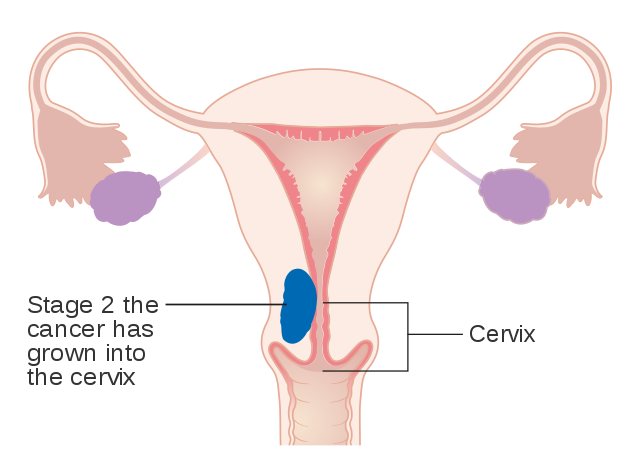Stage 2 Endometrial Cancer is cancer that began in the tissue lining of the uterus and is growing into the supporting connective tissue of the cervix (called the cervical stroma).
Understanding Stage 2 Endometrial Cancer will help you partner with your doctors to make the best treatment choice for you.
Endometrial Cancer Stage 2 ICD 10 is C54.1.
Tap “Listen Now” for an easy-to-understand audio overview of Stage 2 Endometrial Cancer.
- Stage 2 Endometrial Cancer
Overview
Stage 2 Endometrial Cancer diagnosis means that the cancer has spread into the connective tissue of the cervix, but has not spread outside of your uterus.
You can see the cancer here in blue on the right side of the uterus and how it is in the lining but has not gone beyond the uterus.
What Tests Will I Need and Why?
Blood and Imaging tests are done to understand your general health, confirm your diagnosis and determine your cancer stage.
Tissue analysis is also typically done through a biopsy to identify the cancer cell type, which is critical to finding the best treatment option for you.
If your treatment team has not already performed tests to determine your cancer’s features, please ask your doctor when these tests will be performed.
Re-read this summary as needed and then tap, “Compare My Treatment Options Now“. Our unique Comparison Page will help you understand your FDA-approved treatment options including, who can help you pay for your treatment, where and how each is given and what side-effects you may experience.

Cancer Research U.K. CC BY-SA 4
Recommended Endometrial Cancer Videos

Endometrial Cancer In The Black Community
Brought To You By Black Health Matters

Endometrial Cancer Overview
CDC Did You Know Series

How Cancer Spreads
Metastatic = Advanced

Diagnosing Your Cancer
How Does a PET Scan Work?

Diagnosing Your Cancer
How Does a CT Scan Work?

Exercise! You Can Do It
Reducing Side Effects & More
Commonly Searched Questions
Stage 2 Endometrial Cancer Treatment
When endometrial cancer is stage 2, it has spread to the connective tissue of the cervix. But it still hasn’t grown outside the uterus. One treatment option is to have surgery first, followed by radiation therapy.
Source: Cancer.org
Stage 2 Endometrial Cancer Symptoms
One of the most common symptoms of endometrial cancer is abnormal vaginal bleeding. This can include:
- changes in the length or heaviness of menstrual periods
- vaginal bleeding or spotting between menstrual periods
- vaginal bleeding after menopause
- pelvic pain
Source: Cancer.org
Stage 2 Endometrial Cancer Recurrence Rate
The overall prognosis for stage 2 endometrial cancer shows an outcome of 69.8% for the 5-year survival rate, and 17.6% of the patients still experience recurrence.
Source: PubMed.gov
Stage 2 Endometrial Cancer Survival Rate
According to SEER data, Stage 2 Endometrial Cancer has a survival rate of 69.8%. For example, if the 5-year relative survival rate for a specific stage of endometrial cancer is 69.8%, it means that patients who have that cancer are, on average, about 69.8% as likely as patients who don’t have that cancer to live for at least 5 years after being diagnosed.
Source: Cancer.gov
Stage 2 Endometrial Cancer Definition
Stage 2 endometrial cancer is characterized by cancer that has spread beyond the endometrium into the cervix, but has not yet extended to other distant organs. At this stage, the cancer is classified into two sub-stages. In Stage 2A, the cancer has invaded the cervix but remains within the uterus. In Stage 2B, the cancer has spread from the cervix to the surrounding tissue around the uterus. Despite this local extension, the cancer has not yet reached distant sites outside the pelvic region.
Source: Cancer.gov
Stage 2 Endometrial Cancer Prevention
Prevention strategies for Stage 2 endometrial cancer, which has spread to nearby tissues but not beyond the uterus, include:
- Maintain a Healthy Weight: Obesity is a significant risk factor for endometrial cancer.
- Manage Diabetes: Properly manage diabetes to reduce risk.
- Use Birth Control Pills: Oral contraceptives may lower the risk.
- Discuss Hormone Therapy: If undergoing hormone replacement therapy, discuss its risks with your doctor.
Regular gynecological check-ups can help with early detection and risk management.
Source: PubMed.gov





